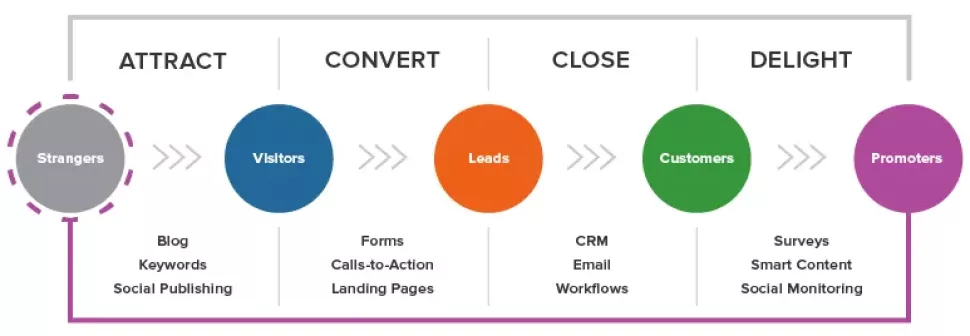
Selling services or products to the right customers, while maintaining a suitable profit margin, is a fundamental requirement for sustaining a business. Recognizing these clients and obtaining their contact information is crucial, yet many companies struggle in this aspect. Learn how to address this issue effectively. If you have been involved in online marketing, you are likely familiar with lead generation campaigns (often abbreviated as lead-gen), which provide a pathway to connect with potential customers.
In exchange for their contact information, you can offer:
- Promotional offers (through newsletters, push notifications, or an e-shop account).
- Bonus content (such as e-books, case studies, webinars, product sheets, etc.).
- Non-binding consultations (particularly popular with B2B companies).
- Free trials of applications (commonly used by SaaS companies).
- Comparisons of different offers, like mortgages or travel insurance.

Source: HubSpot
Once a predefined score is achieved, such as by opening newsletters, the contact transitions into a Marketing Qualified Lead (MQL). An MQL is a user who expresses interest in your offer but isn't yet planning to make a purchase. By accumulating additional points, such as downloading a price list or product sheet, the contact becomes a Sales Qualified Lead (SQL) with a high likelihood of placing an order. Now, a sales specialist can confidently reach out to this user.
Seems simple, right? However…
68% of lead generation campaigns prove to be ineffective.
This claim comes from the APSIS platform's study, specifically addressing B2B organizations. Interestingly, despite being aware of the significance of lead-gen campaigns for securing orders, most of these companies invest at least half of their budget in lead generation.
On average, only 13% of Marketing Qualified Leads (MQLs) are successfully converted into Business Qualified Leads (BQLs). Furthermore, out of this remaining fraction, only 6% of contacts actually make a purchase (Userpilot, 2022). In essence, it takes an average of 128 leads to generate a single deal.
Simultaneously, this sale has to cover a substantial portion of marketing and merchant costs. Therefore, it makes sense to maximize the yield from obtaining quality leads. However, another issue arises in this context.
Who is generating low-quality leads? Mischief Makers, Ghost Busters and others
A significant number of users enter a non-existent contact e-mail and phone number into the form. With exaggeration, we divided them typologically and Midjourney even generated for us what they look like.

Mischief Makers: These sly folks just want to snatch your bonus content and disappear into the shadows. They're the Houdinis of lead generation, entering fake data and vanishing faster than you can say, "Wait, who are you?"

Ghost Busters: Armed with proton emails, these stealthy individuals are on a mission to ward off unknown phone numbers and dodge cyber threats. They create temporary addresses, leaving behind only echoes of their presence after snagging that sweet bonus content.

Turbo Turtles: Eager to kick off a relationship at warp speed, these speedy Gonzales types often end up in the wrong lane. With typos and wrong fields in their wake, they're the racecars that unintentionally crash your lead-gen party.

Pondering Prowlers: These contemplative cats are hesitant to pounce on providing contact details due to the cumbersome form-filling process. Leaving it "for later" often translates to "never" in their world, making them the zen masters of delayed decisions in lead generation.
All of this leads to the following:
- You are burning money unnecessarily on lead-gen campaigns.
- You are burdening your salespeople; repeatedly calling a non-existent number can significantly impact the morale of the team.
- You risk having your email address blacklisted. This occurs when a high number of fake emails in the database results in a newsletter's undeliverability rate exceeding 2%.
3 Proven Tips for Improving the Quality of Lead-Gen Campaigns
We face these common issues with our clients every day. The best fix is to filter out wrong contacts from the beginning. Here's how:
1. Check Phone Numbers
Our insurance client, comparing insurance quotes, had trouble with phone numbers. Even if the user entered a made-up number, it got saved, and consultants couldn't reach the potential customer.
Solution: We added a check for the phone number, making sure it's real. This cuts down on wrong numbers by about 84%.
2. Verify Email Existence
Many e-commerce clients offer discounts for newsletter sign-ups. But sometimes, users give fake emails for a one-time deal, making it hard to connect with them.
Solution: We suggest using email checks during sign-ups. This lowers fake emails by around 91%, making email campaigns work better.
3. Speed up Data Entry
Some clients, especially in B2B, need more info from customers. But if the form is too long, people get discouraged and leads drop.
Solution: Consider using tools to speed up the input of addresses and company information. This accelerates the data entry process, ultimately improving the effectiveness of lead-gen campaigns.
What can we learn from the article?
- Generating high-quality leads depends on users providing accurate email addresses and phone numbers.
- Many visitors input incorrect contact information, either to avoid speaking with a sales representative or due to safety concerns. Additionally, mistakes like filling in the wrong field or making typos are common.
- Real-time contact validation apps identify non-existent email addresses and phone numbers, notifying users. This can significantly decrease the presence of false contact data in the database, reducing it by up to 91%.
- These tools can also quickly retrieve company information.